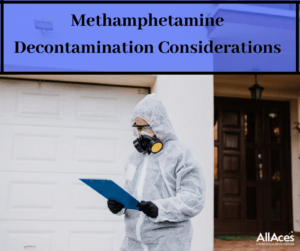
The Problem
Finding methamphetamine residue in your home or building can cause quite a few issues for tenants, landlords, property managers and businesses alike. Health implications along with legal ramifications, are just the beginning of the headache that awaits dealing with this type of issue. Thankfully, with professional and trusted advice, this process can be made much smoother through understanding what exactly goes into each step and how to deal with methamphetamine decontamination.
How it Starts
When methamphetamine is illegally manufactured or consumed through personal usage, its vapours are released into the air and absorbed by everyday household materials such as walls or even furniture. It has been shown that the residue from these vapours can remain present for up to five years and spread to other new furniture introduced into the property. So how do we get rid of it?
What to Consider-Decontamination
The scale of the decontamination process may vary greatly depending on 3 key areas:
These key areas help define how a property’s methamphetamine decontamination should take place because using the right tests and team could save you the headache of inefficient testing, spending and energy.
For instance, if methamphetamine is suspected to have contaminated a property, using a test to clearly define where the spread has been located is crucial as it allows for an accurate job to be done by professionals. If an inaccurate test is used, a one room methamphetamine decontamination job could potentially turn into a full house level decontamination effort which would lead to extra unnecessary costs, a second round of testing and a complete strip of the property. Therefore, it’s important to know the proper process before a house can be fully decontaminated.
The Process of Decontamination
While its effects are detrimental to individuals’ health, as a property owner leasing to new tenants or managing a business; methamphetamine residue could land you into serious legal trouble as the IICRC determines specific thresholds for the risk levels involving methamphetamine residue. So, if you suspect that there may be Methamphetamine present within your property, its’ best to begin the decontamination process by using the most accurate test for your level of certainty that it is present.
If you are unsure whether it is in your property or not, this should be determined by an instant test, which can tell you with certainty the presence of the residue in the building. Its limitations are that it cannot specifically pinpoint the location of the methamphetamine residue nor its concentration levels. This is where composite tests must be used.
If you are confident there is methamphetamine present, choosing between the two types of composite tests, field and lab, may be very useful to you. The field test’s advantages are that its first round of testing is cheaper but is only recommended for testing smaller areas as that is where its’ results are most accurate. It measures all samples as a singular reading with an average to understand the concentration of the residue.
If found that the spread is not only contained in a singular area, a level 3 testing must be used, and this is extremely costly as the entire property must be stripped to make sure all residue is measured and decontaminated correctly. The lab composite test is an alternative to this as it measures test samples of the suspected residue individually and can more accurately tell you where the exact location and strength of the residue lies. A follow up test may be made for lab tests but is nowhere near as expensive as a level 3 test from an initial field test.
The final option, a discrete test should only be used when the resident or property owner is certain that the methamphetamine residue is well above the IICRC threshold. This is because while it is the most accurate test that can provide knowledge on the location and strength of the residue, it is the most costly by far and could set owners back by a significant amount if they are unsure about the presence or degree of methamphetamine present in their property.
Next steps…
After a full testing has taken place, it’s important to note your main purpose for restoring this property. Whether it be to remain within the legal boundaries of the IICRC and continue operations with accommodating tenants or even to create a new appeal, by getting the degree of restoration you require for your property, we can work together with you to achieve your best desired outcome in the most efficient manner.
Why Us?
With over 30 years of industry experience and multiple accreditations, All Aces guarantees the best cleaning and restoration outcomes! This is established by providing our clients with effective, efficient, timely and sustainable solutions. All Aces is committed to ensuring its services are always first-rate by delivering professionalism, reliability, and genuine expert advice. There is no shortcut to great results, and however the property needs to be restored, we will ensure that our quality stands by our word.
To learn more about our meth cleaning services click here